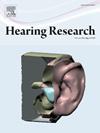Assessing Behavioral and Neural Correlates of Change Detection in Spatialized Acoustic Scenes
IF 2.5
2区 医学
Q1 AUDIOLOGY & SPEECH-LANGUAGE PATHOLOGY
引用次数: 0
Abstract
The ability to detect changes in complex auditory scenes is crucial for human survival, yet the neural mechanisms underlying this process remain elusive. This study investigates how the presence and location of sound sources impacts active auditory change detection as well as neural correlates of passive change detection. Stimuli were naturalistic temporal envelopes applied to synthesized broadband carriers designed to eliminate semantics and minimize contextual information while preserving naturalistic temporal envelopes and broadband spectra, presented in a spatial loudspeaker array. Behavioral change detection experiments tasked participants with detecting new sources added to spatialized and non-spatialized multi-source auditory scenes. In a passive listening experiment, participants were given a visual decoy task while neural data were collected via electroencephalography (EEG) during exposure to unattended spatialized scenes and added sources.
Our two behavioral experiments (N = 21 and 21) demonstrated that spatializing sounds facilitated change detection compared to non-spatialized presentation, but that performance declined with increasing number of sound sources and higher hearing thresholds at mid-high frequencies, exclusively in spatialized conditions. Slower reaction times were also observed when changes occurred from above or behind the listener, exacerbated by a higher number of sources. Two EEG experiments (N = 32 and 30), using the same stimuli, showed robust change-evoked responses. However, no significant differences were detected in our analysis as a function of spatial location of the appearing source. These findings provide fresh insights into the mechanisms of spatial auditory change detection, emphasizing the dynamic interplay of spatial cues, change location, and scene complexity.
评估空间化声学场景中变化检测的行为和神经关联
探测复杂听觉场景变化的能力对人类生存至关重要,但这一过程背后的神经机制仍然难以捉摸。本研究探讨了声源的存在和位置如何影响主动听觉变化检测以及被动听觉变化检测的神经相关因素。刺激是应用于合成宽带载波的自然时间包络,旨在消除语义和最小化上下文信息,同时保留空间扬声器阵列中呈现的自然时间包络和宽带频谱。行为改变检测实验要求参与者检测添加到空间化和非空间化多源听觉场景中的新源。在被动聆听实验中,被试被赋予视觉诱饵任务,同时通过脑电图(EEG)收集被试在暴露于无人看管的空间化场景和附加源时的神经数据。我们的两个行为实验(N = 21和21)表明,与非空间化呈现相比,空间化声音有助于变化检测,但在中高频条件下,随着声源数量的增加和听力阈值的提高,这种表现会下降,只在空间化条件下。当变化发生在听者的上方或背后时,反应时间也会变慢,而更多的源会加剧这种变化。两个EEG实验(N = 32和30),使用相同的刺激,显示出稳健的变化诱发反应。然而,在我们的分析中,作为出现源的空间位置的函数,没有发现显着差异。这些发现为空间听觉变化检测机制提供了新的见解,强调了空间线索、变化位置和场景复杂性的动态相互作用。
本文章由计算机程序翻译,如有差异,请以英文原文为准。
求助全文
约1分钟内获得全文
求助全文
来源期刊

Hearing Research
医学-耳鼻喉科学
CiteScore
5.30
自引率
14.30%
发文量
163
审稿时长
75 days
期刊介绍:
The aim of the journal is to provide a forum for papers concerned with basic peripheral and central auditory mechanisms. Emphasis is on experimental and clinical studies, but theoretical and methodological papers will also be considered. The journal publishes original research papers, review and mini- review articles, rapid communications, method/protocol and perspective articles.
Papers submitted should deal with auditory anatomy, physiology, psychophysics, imaging, modeling and behavioural studies in animals and humans, as well as hearing aids and cochlear implants. Papers dealing with the vestibular system are also considered for publication. Papers on comparative aspects of hearing and on effects of drugs and environmental contaminants on hearing function will also be considered. Clinical papers will be accepted when they contribute to the understanding of normal and pathological hearing functions.
 求助内容:
求助内容: 应助结果提醒方式:
应助结果提醒方式:


